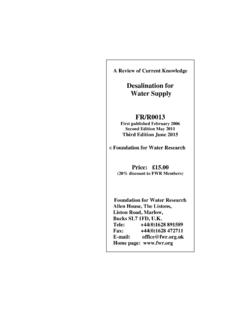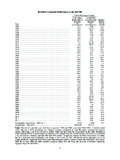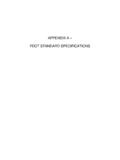Transcription of CROSSING THE THRESHOLD - New York City
1 BILL DE BLASIO, Mayor | RICHARD D. EMERY, Esq., Chair | MINA Q. MALIK, Esq., Executive DirectorCROSSING THE THRESHOLD : An Evaluation of Civilian Complaints of Improper Entries and Searches by the NYPD from January 2010 to October 62/8/2016 1:53:20 AMi CCRB MISSION AND VALUES The New york city Civilian Complaint Review Board (the CCRB or the Board ) is an independent agency, created by Chapter 18-A of the New york city Charter. The Board is empowered to receive, investigate, prosecute, mediate, hear, make findings, and recommend action on complaints against New york city police officers alleging the use of excessive or unnecessary force, abuse of authority, discourtesy, or the use of offensive language. In fulfillment of its mission, the Board has pledged: To report apparent patterns of misconduct, relevant issues and policy matters to thePolice Commissioner and the 2015 by the New york city Civilian Complaint Review Board 100 Church Street, 10th Floor, New york , NY 10007 CCRB URL: To obtain additional information, contact: General Information: Telephone: (212)-912-2061 or (800)-341-2272 Or visit, i CROSSING THE THRESHOLD : An Evaluation of Civilian Complaints of Improper Entries and Searches by the NYPD from January 2010 to October 2015 TABLE OF CONTENTS CCRB Mission and Values i Table of Contents i Table of Figures i Executive Summary 2 Introduction: Background of CCRB and Glossary 11 Section One.
2 The Scope of the Study Statistics and Methodology 14 Relevant Complaint Activity 14 Relevant Complaint Dispositions 15 Methodology 18 Section Two: Entering Premises Law and Police Practices 20 Law on Entries 20 NYPD Patrol Guide 21 NYPD Police Student s Guide 23 NYPD Operations Orders and Legal Bulletins. 24 Section Three: Examining Police Conduct in Substantiated Complaints 25 A. Occupants Do Not Provide Valid Consent 25 B. No Exigent or Emergency Circumstances Justify Warrantless Entry 35 C. Hot Pursuit Did Not Justify Warrantless Entry 47 D. Plain View Doctrine Misapplied to Entries and Seizures 51 E. Investigation Cards Are Improperly Used to Gain Entry into Premises 52 F. Improper Execution and Use of Warrants to Gain Entry into Premises 56 ii b. Officers Fail to Show Warrants to Occupants 59 Section Four.
3 Relevant Characteristics of Substantiated Complaints 61 Location of Improper Entries and Searches 61 Types of Premises Searched 64 Time of Day 65 Characteristics of Victims in Relevant Complaints 65 Characteristics of Subject Officers in Relevant Complaints 67 Command and Assignment of Subject Officers 68 Ranks of Subject Officers 71 Tenure and Complaint History of Subject Officers 71 Plainclothes 73 Manner of Entry 73 Damage to Property Allegations 74 Arrests after Improper Entry 75 Use of Force Allegations and Alleged Injuries to Victims 75 Discourtesy and Offensive Language Allegations 76 Presence of Notice of Claim or Civil Lawsuit 76 False Official Statements 77 Failure to Complete a Memo Book Entry 78 Presence of Video, Audio or Relevant Photographs 78 Section Five: Discipline and Penalties in Substantiated Cases 79 Analysis of Disciplinary Decisions in Administrative Proceedings 83 Analysis of Non-Charges Cases 87 Section Six: A Review of Exonerated, Unsubstantiated, and Officer Unidentified Allegations 89 Exonerated Entry and Search Allegations 89 Unsubstantiated Entry and Search Allegations 92 Failure to Show a Warrant Allegations 93 Officer Unidentified Complaints 93 Section Seven: CCRB Recommendations 94 Appendix A: Commands of Subject Officers 104 i TABLE OF FIGURES Figure 1: Number of Complaints and Allegations of Premises Entry, Search, and Failure to Show a Warrant Received By Year between 1/1/2010 and 10/1/ 2015 .
4 15 Figure 2: Total CCRB Complaints Received By Year between 1/1/2010 and 10/1/ 2015 .. 15 Figure 3: Disposition of Fully Investigated Allegations of Premises Entry, Search, and Failure to Show Warrant Between 1/1/2010 and 10/1/ 2015 .. 17 Figure 4: Disposition by Year of Fully Investigated Allegations of Premises Entry, Search, and Failure to Show Warrant Between 1/1/2010 and 10/1/ 2015 .. 18 Figure 5: Consent Issues in Substantiated Entry and Search Complaints .. 26 Figure 6: Exigent or Emergency Circumstances Issues in Substantiated Entry and Search Complaints .. 37 Figure 7: Investigation Cards and Warrants in Substantiated Entry and Search Complaints .. 54 Figure 8: Substantiated Entry and Search Complaints In Which Warrants Did Not Authorize Entry .. 58 Figure 9: Complaints by Borough of Premises Entry, Premises Search, and Failure to Show a Warrant Substantiated Between 1/1/2010 and 10/1/ 2015 .
5 62 Figure 10: Complaints by Precinct of Premises Entry, Premises Search, and Failure to Show a Warrant Substantiated Between 1/1/2010 and 10/1/ 2015 .. 63 Figure 11: Type of Residential Premises in Substantiated Complaints .. 64 Figure 12: Substantiated Complaints by Time of Incident (All Commands) (#) .. 65 Figure 13 Substantiated Complaints by Time of Incident (Warrant Squad Only) (#) .. 65 Figure 14: Race of Alleged Victims and Victim/Complainants in Substantiated Complaints Compared to New york city Demographics .. 66 Figure 15: Sex of Alleged Victims and Victim/Complainants in Substantiated Complaints Compared to New york city Demographics .. 67 Figure 16: Race of Subject Officers in Substantiated Allegations Compared to NYPD Demographics .. 67 Figure 17: Command of Subject Officers in Substantiated Allegations.
6 69 Figure 18: Assignment of Patrol and Housing Bureau Subject Officers in Substantiated Allegations .. 70 Figure 19: Rank of Subject Officers in Substantiated Allegations .. 71 Figure 20: Tenure of Subject Officers at Time of Substantiated Incident (Years) .. 72 Figure 21: Number of Complaints before Incident by Number of Subject Officers (#) .. 72 Figure 22: Manner of Entry in Substantiated Entry 74 Figure 23: CCRB Disciplinary Recommendations in Substantiated Premises Entry, Search, and Warrant Allegations .. 80 Figure 24: CCRB Disciplinary Recommendations By Year in Substantiated Premises Entry, Search, and Warrant Allegations .. 81 Figure 25: Police Department Discipline in All Substantiated Premises Entry, Search, and Warrant Allegations .. 82 Figure 26: Police Department Discipline in Allegations with Charges Recommendation.
7 84 Figure 27: Police Department Discipline in Allegations with Command Discipline Recommendation .. 87 Figure 28: Police Department Discipline in Allegations with Formalized Training Recommendation .. 88 Figure 29: Police Department Discipline in Allegations with Instructions Recommendation .. 88 Figure 30: Bases for All Exonerated Entry and Search Allegations .. 90 Figure 31: Bases for Exoneration in Sample of Exonerated Allegations .. 90 2 EXECUTIVE SUMMARY Police search and seizure especially of homes represents one of the most invasive forms of intrusion of individual liberty. When conducted without proper constitutional authority, home searches are one of the most serious violations of privacy and, consequently, types of police misconduct that engender anger at and distrust of police authority.
8 Entries are fraught with a range of potential dangers to both civilians and officers. Many officers enter homes early in the morning when occupants are sleeping, in a state of undress, and engaged in the private routines in preparation for the day ahead often leaving residents and their children frightened, confused, and angry. Police officers find themselves in chaotic and potentially dangerous situations, with an unknown number of occupants in the home and limited knowledge of what they will encounter. Even when done lawfully, police entries are forceful, aggressive and surprising, intended to apprehend suspects and seize evidence of a crime. Data compiled by CCRB indicates that most officers in the New york Police Department (the NYPD or Department ) enter homes to respond to crimes-in-progress, to render aid to residents, or pursuant to valid search or arrest warrants.
9 Yet the cost of loss of confidence in the presumption of lawful conduct as a result of the cohort of improper entries and searches far outweighs their modest prevalence. Not only are core civil liberties violated, but the necessary constructive relationship between community members and the police is degraded. The community s tolerance for law enforcement activity and compliance with the law rises and falls upon its sense of police legitimacy and authority. Where officers fail to act in accordance with the law requiring procedural and substantive warrant requirements, civilians lose trust and confidence in the police. A lack of procedural justice contributes to a perception that police ignore the law s constraints. To understand the nature and scope of civilian complaints regarding police search and seizure at premises, the CCRB conducted a study of over five and a half years of fully investigated complaints.
10 The CCRB is the largest police oversight agency in the nation and is empowered to receive, investigate, make findings and recommend action upon complaints by New Yorkers alleging misconduct by NYPD officers. See NYC Charter 440(c)(1). To further this mission, CCRB issues monthly, biannual, and special statistical and qualitative reports analyzing trends and recurring issues arising from the many thousands of civilian complaints it receives. These reports act as a barometer of police-civilian encounters in a number of ways, including the police practices that civilians find most troubling. In its role as an independent investigator of misconduct allegations, CCRB is uniquely positioned to identify the circumstances that generate civilian complaints, to assess whether officer conduct is improper, and to offer recommendations to redress misconduct.















